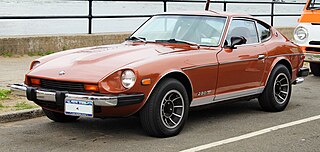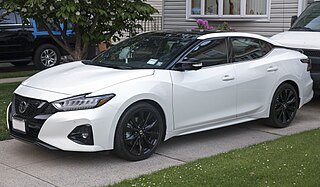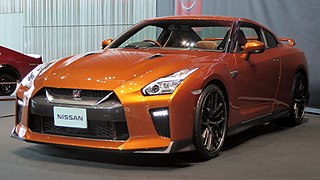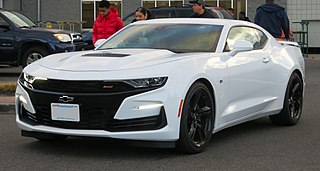
The Nissan Z-cars are a model series of sports cars that have been manufactured by Nissan Motors Ltd, in seven generations, since 1969.

The Nissan Skyline GT-R is a sports car based on the Nissan Skyline range. The first cars named "Skyline GT-R" were produced between 1969 and 1972 under the model code KPGC10, and were successful in Japanese touring car racing events. This model was followed by a brief production run of second-generation cars, under model code KPGC110, in 1973.

The Honda Integra, marketed in North America as the Acura Integra, is an automobile produced by the Japanese automobile manufacturer Honda from 1985 until 2006, and then since 2021. It succeeded the Quint as a more luxurious and sport-oriented derivative of the Civic. The Integra was one of the launch models for Acura in the US in 1986 alongside Acura Legend. Throughout its life, the Integra was highly regarded for its handling and performance. The 1995–2001 DC2 Integra Type R is widely regarded as one of the best front-wheel-drive cars of all time.

The Nissan Maxima is a full-size car manufactured and marketed by Nissan and offered as Nissan's flagship sedan primarily in North America, the Middle East, and China — and currently in its eighth generation. Having debuted for model year 1982 as the Datsun Maxima, it replaced the earlier Datsun 810. The name Maxima dates to model year 1981 when Datsun marketed the upscale 810 as the 810 Maxima in North America. Like the 810, early versions of the Maxima had their origins in the Datsun/Nissan Bluebird. It is renamed to Nissan Maxima when the Datsun brand was phased out for model year 1985.

The Fiat Stilo is a small family car available as a three door and a five door hatchback, as well as an estate, produced by the Italian automaker Fiat. The Stilo three door and five door were launched in November 2001, at the Bologna Motor Show, to replace the Fiat Bravo/Brava, with the Stilo Multi Wagon following in January 2003.

The Nissan 350Z is a two-door, two-seater sports car that was manufactured by Nissan Motor Corporation from 2002 until 2009 and marks the fifth generation of Nissan's Z-car line. The 350Z entered production in 2002 and was sold and marketed as a 2003 model from August 2002. The first year there was only a coupe, as the roadster did not debut until the following year. Initially, the coupe came in Base, Enthusiast, Performance, Touring and Track versions, while the Roadster was limited to Enthusiast and Touring trim levels. The Track trim came with lightweight wheels and Brembo brakes, but its suspension tuning was the same as all other coupes. The Nissan 350Z was succeeded by the 370Z for the 2009 model year.

The Nissan Almera is a line of automobiles that has been manufactured by the Japanese car manufacturer Nissan since 1995. For its early generations, the Almera is a compact car (C-segment), essentially being the European export-market version of the Pulsar for the first-generation model (N15), and the Bluebird Sylphy for the second-generation model (N16). Since the third-generation model (N17), the Almera nameplate was repositioned to a subcompact or B-segment sedan based on the V platform. The N17 Almera is marketed globally with the usage of five other nameplates for various markets.

The Nissan Cefiro is a front-engine, five passenger, mid-size passenger car manufactured and marketed by Nissan Motors over three generations. Almost all Cefiro's were marketed as four-door sedans, though a five-door wagon body style was briefly available (1997-2000). In most cases, the Cefiro used Nissan's VQ six-cylinder engines, named Ward's 10 Best Engines more than ten years running.

The Nissan Patrol is a series of full-size SUVs manufactured by Nissan in Japan and sold throughout the world.

The Nissan Sentra is a series of automobiles manufactured by the Japanese automaker Nissan since 1982. Previously subcompact in classification, for the model year 2000 it was reclassified as a compact car. Until 2006, Sentra was a rebadged export version of the Japanese Nissan Sunny, but since the 2013 model year, Sentra is a rebadged export version of the Sylphy. The Sentra nameplate is not used in Japan. Many other countries in South America sell their versions of the Sunny as the Sentra. In Mexico, the first three generations of the Sentra were known as the Nissan Tsuru, and the B13 model was sold under that name until 2017, alongside the updated models badged as Sentra.

The Nissan Pulsar is a line of automobiles produced by the Japanese automaker Nissan from 1978 until 2000, when it was replaced by the Nissan Bluebird Sylphy in the Japanese market.

Drifting is a driving technique where the driver intentionally oversteers, with loss of traction, while maintaining control and driving the car through the entirety of a corner. The technique causes the rear slip angle to exceed the front slip angle to such an extent that often the front wheels are pointing in the opposite direction to the turn. Drifting is traditionally done by clutch kicking, then intentionally oversteering and countersteering. This sense of drift is not to be confused with the four wheel drift, a classic cornering technique established in Grand Prix and sports car racing.

The Chevrolet Corvette (C3) is a sports car that was produced from 1967 until 1982 by Chevrolet for the 1968 to 1982 model years. Engines and chassis components were mostly carried over from the previous generation, but the body and interior were new. It set new sales records with 53,807 produced for the 1979 model year. The C3 is the third generation of the Chevrolet Corvette, and marks the second time the Corvette would carry the Stingray name, though only for the 1969 - 1976 model years. This time it was a single word as opposed to Sting Ray as used for the 1963 - 1967 C2 generation. The name would then be retired until 2014 when it returned with the release of the C7.

The Nissan 180SX is a fastback automobile that was produced by Nissan Motors between 1988 and 1998. It is based on the S13 chassis from the Nissan S platform with the variants receiving an R designation, and was sold exclusively in Japan paired with the CA18 motor in the early models; later models paired with the SR20 motor. Outside of Japan, it was re-badged as the 200SX and in the US market as the Nissan 240SX, paired with the single overhead cam KA24E motor and later with the dual-overhead model KA24DE.

The Nissan R390 GT1 was a racing car built in Atsugi, Japan. It was designed primarily to gain a suitable racing entry in the 24 Hours of Le Mans in 1997 and 1998. It was built to race under the grand touring style rules, requiring a homologated road version to be built. Therefore, the R390 was built originally as road car, then a racing version of the car was developed afterwards. Only one R390 road car was ever built and is stored at Nissan's Zama facility. The road car was claimed to be capable of attaining a top speed of 354 km/h (220 mph). However, this claim has never been proven.

The Nissan Rogue is a compact crossover SUV produced by the Japanese automobile manufacturer Nissan. It made its debut in October 2007 for the 2008 model year. Beginning in 2013 for the 2014 model year, the model has been paralleled with the X-Trail sold outside the United States and Canada, making them identical. It is currently Nissan's best-selling vehicle in the United States.

The Nissan GT-R, is a high-performance sports car and grand tourer produced by Nissan unveiled in 2007. It is the successor to the Skyline GT-R, a high performance variant of the Nissan Skyline. Although this car was the sixth-generation model to bear the GT-R name, the model is no longer part of the Nissan Skyline model lineup since that name is now reserved for Nissan's luxury-sport vehicles. The GT-R built on the exclusively developed Nissan PM platform, which is an enhanced evolution of the Nissan FM platform used in the separate Nissan Skyline luxury car and the Nissan Z sports car. The GT-R abbreviation stands for Gran Turismo–Racing, obtained from the Skyline GT-R.

The Nissan Silvia is the series of small sports cars built on the Nissan S platform. Versions of the Silvia have been marketed as the 200SX or 240SX for export, with some export versions being sold under the Datsun brand.

The sixth-generation Chevrolet Camaro is an American pony car. Produced by automobile manufacturer Chevrolet, it was first introduced to the public on May 16, 2015. Sales started in 2015 for the 2016 model year. The Camaro now utilizes the GM Alpha platform shared with the Cadillac ATS and CTS and features MacPherson struts in front, rather than the former multi-link setup. General Motors claims that 70 percent of architectural components in the new Camaro are unique to the car.

The Nissan Z is a sports car manufactured by Nissan. The model is the seventh generation of the Nissan Z-car line, succeeding the 370Z, though allegedly retaining the "Z34" model designation of it. The model also drops the numerical nomenclature of the previous generations.



















